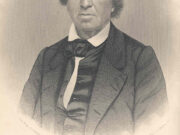James Osgood Andrew was a nineteenth-century Methodist Episcopal Church bishop whose possession of enslaved people generated controversy within the denomination. Andrew became the symbol of the slavery issue that divided the church in 1844 and instigated the separation of northern and southern Methodist Episcopalians the following year.
The son of Mary Cosby and John Andrew, James Osgood Andrew was born in Wilkes County on May 3, 1794. In 1789 his father became the first native Georgian to enter the Methodist ministry. Young Andrew was licensed to preach by the South Carolina Conference in 1812. The first twenty years of his ministry included the Salt Ketcher Circuit in South Carolina, Bladen Circuit in North Carolina, and the Augusta and Savannah circuits in Georgia. In 1824 he was appointed presiding elder of the Edisto district, which included Charleston, South Carolina. From 1820 to 1832, he was elected delegate to the quadrennial General Conferences, and in 1832 he was chosen bishop. Andrew moved from Augusta to Newton County in 1836 to be near the Methodist Manual Labor School, of which he was a trustee. This institution later became Emory College at Oxford. His Episcopal assignments took him to annual conferences throughout the south and west.

The details surrounding Andrew’s status as a slave owner, and particularly the way in which he acquired them, are the subject of some debate. According to most published accounts, Andrew never bought or sold an enslaved person; rather he had become a slave owner through his wives. In 1816 Andrew married Ann Amelia MacFarlane, with whom he had six children. Upon her death in 1842, she bequeathed him an enslaved person. Andrew’s second wife, Leonora Greenwood, whom he married in 1844, was also a slave owner. When she died in 1854, he married Emily Sims Childers.
Some evidence exists, however, to suggest that Andrew may have first acquired enslaved people earlier than 1842. A man named James Osgood Andrew is listed on the 1830 Athens census as the owner of two enslaved persons, although this man may not have been the bishop. The U.S. census of 1840, taken four years after Andrew is known to have moved to Newton County, lists him as a resident of that county and the owner of thirteen enslaved persons.
Andrew’s status as an enslaver, by whatever means, was contrary to Episcopal custom. A growing abolitionist movement was evident within Methodist ranks at the General Conference of 1844. The real issue was whether or not the Methodist Episcopal Church would accept or disapprove of slavery. Northern delegates sponsored a resolution asking Andrew to”desist” from exercising the Episcopal office as long as he owned enslaved people. Southern delegates countered that the church would be destroyed in states that prohibited emancipation. The resolution passed by a vote of 110 to 69. A Plan of Separation between northern and southern Methodist Episcopalians resulted, and the next year representatives of the Southern Annual Conferences met in Louisville, Kentucky, to organize their own church. The first General Conference of the Methodist Episcopal Church, South, assembled in Petersburg, Virginia, in 1846, and Andrew was invited to preside.
During his career, Andrew contributed to religious periodicals and published two books, Family Government (1846) and Miscellanies (1854). During the Civil War (1861-65), he resided in Summerfield, Alabama. After his retirement in 1866, Andrew continued to conduct church conferences when his health permitted. He died in the home of a daughter and son-in-law, the Reverend and Mrs. J. W. Rush, in Mobile, Alabama, in 1871, and was buried in Oxford. Andrew College in Cuthbert is named for him.






